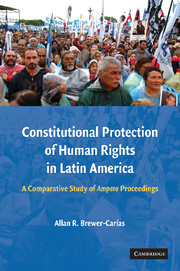 Constitutional Protection of Human Rights in Latin America
Constitutional Protection of Human Rights in Latin America Book contents
- Frontmatter
- Contents
- INTRODUCTION
- PART ONE THE CONSTITUTIONAL AND INTERNATIONAL DECLARATION OF HUMAN RIGHTS AND ITS JUDICIAL GUARANTIES
- PART TWO THE AMPARO AS A LATIN AMERICAN CONSTITUTIONAL AND INTERNATIONAL LAW INSTITUTION
- PART THREE THE INJURED PARTY AND THE CONSTITUTIONAL RIGHTS PROTECTED BY MEANS OF THE AMPARO PROCEEDING
- PART FOUR THE INJURY, THE INJURING PARTY AND THE INJURING ACTS OR OMISSIONS IN THE AMPARO PROCEEDING
- Chapter Twelve The General Conditions of the Injury (Harms and Threats)
- Chapter Thirteen The Reparable Character of the Harms and the Restorative Character of the Amparo Proceeding
- Chapter Fourteen The Imminent Character of the Threats and the Preventive Character of the Amparo Proceeding
- Chapter Fourteen The Injuring Party: The Defendant (Public Entities or Private Individuals)
- Chapter Sixteen The Injuring Public Actions and Omissions of Public Authorities Causing the Harms or the Threats
- PART FIVE THE EXTRAORDINARY CHARACTER OF THE AMPARO PROCEEDING
- CONCLUSION
- APPENDIX A List of Latin American Constitutions
- APPENDIX B List of Latin American Amparo Laws (Statutes)
- INDEX
Chapter Twelve - The General Conditions of the Injury (Harms and Threats)
Published online by Cambridge University Press: 08 August 2009
- Frontmatter
- Contents
- INTRODUCTION
- PART ONE THE CONSTITUTIONAL AND INTERNATIONAL DECLARATION OF HUMAN RIGHTS AND ITS JUDICIAL GUARANTIES
- PART TWO THE AMPARO AS A LATIN AMERICAN CONSTITUTIONAL AND INTERNATIONAL LAW INSTITUTION
- PART THREE THE INJURED PARTY AND THE CONSTITUTIONAL RIGHTS PROTECTED BY MEANS OF THE AMPARO PROCEEDING
- PART FOUR THE INJURY, THE INJURING PARTY AND THE INJURING ACTS OR OMISSIONS IN THE AMPARO PROCEEDING
- Chapter Twelve The General Conditions of the Injury (Harms and Threats)
- Chapter Thirteen The Reparable Character of the Harms and the Restorative Character of the Amparo Proceeding
- Chapter Fourteen The Imminent Character of the Threats and the Preventive Character of the Amparo Proceeding
- Chapter Fourteen The Injuring Party: The Defendant (Public Entities or Private Individuals)
- Chapter Sixteen The Injuring Public Actions and Omissions of Public Authorities Causing the Harms or the Threats
- PART FIVE THE EXTRAORDINARY CHARACTER OF THE AMPARO PROCEEDING
- CONCLUSION
- APPENDIX A List of Latin American Constitutions
- APPENDIX B List of Latin American Amparo Laws (Statutes)
- INDEX
Summary
Regarding the general conditions that the injuries to constitutional rights must comply in order for an amparo actions to be admitted, the following are the ones commonly established in the Latin American Amparo Laws: first, it must have a personal and direct character, in the sense that it must personally affect the plaintiff; second, it must be actual and real; third, it must be manifestly or ostensibly arbitrary, illegal and illegitimate; fourth, it must be evidenced in the case; and fifth, it must not be consented to by the plaintiff.
THE PERSONAL AND DIRECT CHARACTER OF THE INJURY
The first condition of the injury inflicted to the plaintiff's constitutional rights, in order for an amparo action to be admitted, is that the plaintiff must have suffered a “direct, personal and present harm or threat in his constitutional rights,” that is, the plaintiff must be personally affected. Consequently, the amparo action cannot be file when the affected rights belong to another person different to the claimant or only affects the plaintiff in an indirect way.
The plaintiff then, must necessarily be the “affected” person as it is called in Argentina (Article 5) and Peru (Article 39); or the “aggrieved” person, as it is called in Nicaragua (Article 23); or the one who “suffers” the harm, as it is referred to in Brazil (Article 1).
- Type
- Chapter
- Information
- Constitutional Protection of Human Rights in Latin AmericaA Comparative Study of Amparo Proceedings, pp. 261 - 275Publisher: Cambridge University PressPrint publication year: 2008


